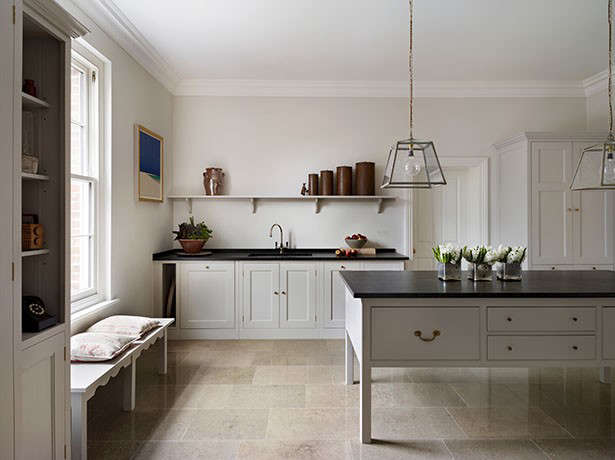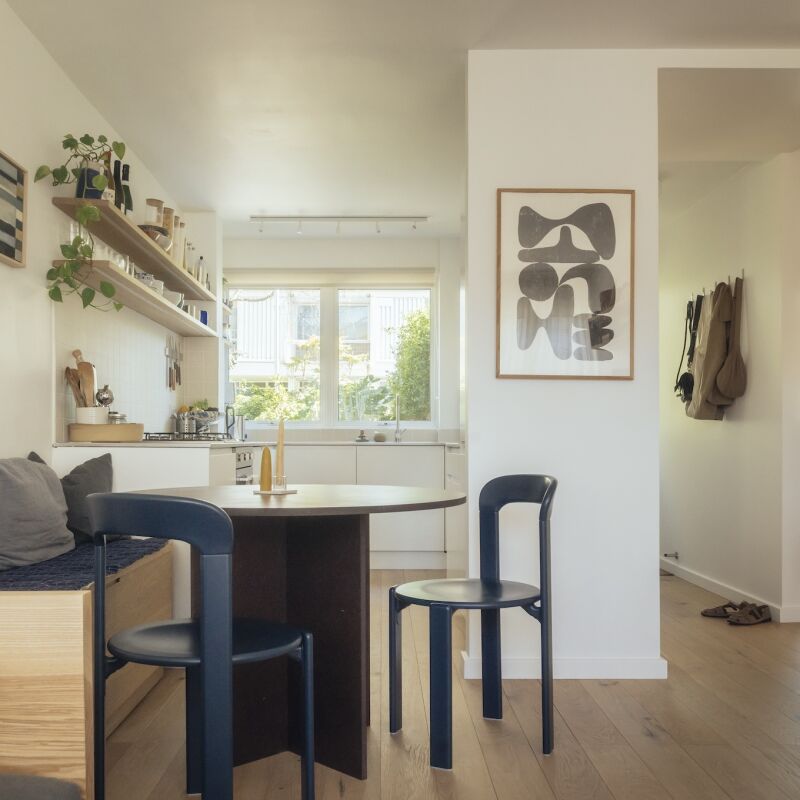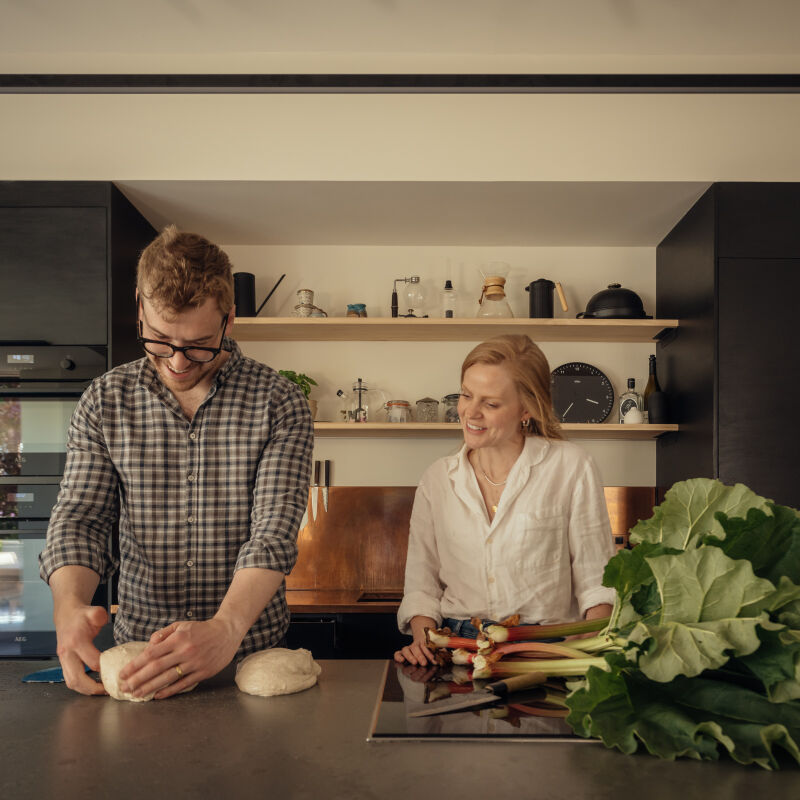Plain English kitchens (and more recently the company’s less-pricey offshoot, British Standard) have struck a chord with designs that have a modern-rustic, pared-down style that’s at once simple and inviting. We talked to founder and creative designer Katie Fontana and asked her to explain how she achieves the look.
Her own foray into kitchen design was accidental. Twenty years ago, when she and business partner, Tony Niblock (her husband at the time), were looking to buy kitchen fittings for their house in Suffolk, it was impossible to find plain, straightforward cupboards, and so out of frustration, Fontana had some made. When the house was featured in a magazine, the ensuing interest in the cupboards inspired the two to set up their own joinery company. Using their house as the showroom, Plain English was born.
Plain English sells and installs complete kitchens from the company’s existing designs–with evocative names like Suffolk Rectory–that are tailored for each setting and often feature bespoke cabinets. We keep hoping the company will decide to open a US branch. Until then, here’s how to get the look in your own kitchen.

Above: Plain English’s Georgian Lodge design.
Remodelista: Plain English kitchens have an effortless warmth to them. How do you achieve this?
Katie Fontana: Wherever I work, I make it homey. I don’t like an office feel, so I make my surroundings comfortable and nest-like. I’m that way with kitchens, too: when I design a showroom kitchen, I imagine myself living in the space and I put all the things that I like in it, whether the setup is modern or old fashioned. Aside from a lived-in look, Plain English kitchens are also really well made; the quality is noticeable and definitely contributes to the warmth.
RM: What’s your approach to design?
KF: I begin with the architecture of the building and take my cues from it. If a room has a tall ceiling or a barrel-vaulted one, I play that up rather than ignore it. I like the grand gesture.

Above: The Merchant’s House kitchen.
RM: A key design element?
KF: The Aga stove–it’s a huge, warm and glowing, homely thing that everyone gravitates to. If an Aga is out of the question, I’ll suggest a range from La Cornue since they have the same sort of presence. For something less commanding, there is the Everhot, a good small-space solution. Regardless of what’s used, I like the cooker to be a key focal point; sometimes I introduce a big hood or two side-by-side stoves.
RM: If you’re on a budget, what’s the one thing you should not scrimp on when designing a kitchen?
KF: The backdrop should be right before you put in the cupboards. Personally, I would never skimp on the finishes. Beautiful floors of flagstone, 18th-century clay tiles, or wide wooden boards make a huge difference. At first glance you might not pick up on what is creating that feeling, but subliminally these things are important. And they don’t have to be expensive: old-fashioned linoleum or checkered tiles can work, but they have to be done right.

Above: Inset copper sinks in a Plain English design featuring the Adam Bray color palette.
RM: Sinks?
KF: The sink is the focal point in the kitchen that you can play up or down. We use a wide spectrum of sinks, from stainless steel to china to concrete. I recently paired two magnificent copper sinks side by side, and I also found a large double farmhouse sink made of slate in the States–I haven’t been able to find anything as good here in the UK.
RM: Faucets?
KF: I find that a lot of taps are over-designed–they are like caricatures of taps. I like to use reclaimed designs, but they’re becoming increasingly hard to find, and customers, of course, often want something more reliable. We appreciate the styling of UK firm Czech and Speake.

Above: A basic design (here in shocking blue) from British Standard, Plain English’s more affordable line.
RM: Do you have a source for the knobs and pulls you use?
KF: I keep my eyes open all the time for vintage hardware and put together collections of old and modernist brass, aluminum, and stainless steel. A lot of the British basics are starting to fall by the wayside, unfortunately, and I would like to find a manufacturer of those things that are disappearing.
RM: Kitchen lighting?
KF: I’m a bit old fashioned when it comes to lighting–I like a mix of pendant and wall lights or sconces. Best & Lloyd lighting is really good. I’ve done recessed lighting in many kitchens, but it should be very discreet.

Above: The London Villa kitchen in tonal blues and whites.
RM: The cupboards?
KF: You can transform plain cupboards just by what you put around them. Add bricks or stainless steel for an industrial look, or introduce color and ironwork for a very different feel.
RM: Your own kitchen?
KF: I am not a practical person; if I like a ridiculous stove, I will happily live with it. I am admittedly more about look and feel than practicality in my own kitchen.
Contemplating a kitchen remodel or touch up? See 15 Essential Tips for Designing the Kitchen, and don’t miss our gallery of posts about Plain English kitchens.
Frequently asked questions
What is a Plain English Kitchen?
A Plain English Kitchen is a design style that is characterized by simplicity, functionality, and quality. It emphasizes the use of natural materials, traditional craftsmanship, and clean lines.
What are the key features of a Plain English Kitchen design?
Key features of a Plain English Kitchen design include natural materials, such as wood and stone, a focus on functionality and storage, simplicity and clean lines, and attention to detail and craftsmanship.
How can I achieve a Plain English Kitchen design?
To achieve a Plain English Kitchen design, focus on using natural materials such as wood and stone, choose simple cabinetry and hardware, and prioritize functionality and storage over decorative elements. Pay attention to details such as lighting and craftsmanship.
What are the benefits of a Plain English Kitchen design?
A Plain English Kitchen design is timeless and classic, and emphasizes simplicity and quality. It can increase the functionality and storage capacity of your space while also creating a calm and peaceful environment.
Is a Plain English Kitchen design expensive?
A Plain English Kitchen design can be more expensive than other styles, as it often emphasizes high-quality materials and craftsmanship. However, it is also a timeless and classic design that can add value to your home.
What are some design tips for achieving a Plain English Kitchen?
Some design tips for achieving a Plain English Kitchen include using natural materials such as wood and stone, choosing simple and functional cabinetry, focusing on storage and organization, using traditional craftsmanship, and paying attention to details such as lighting and hardware.




Have a Question or Comment About This Post?
Join the conversation